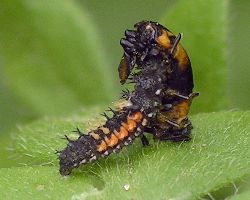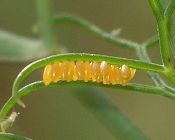 | 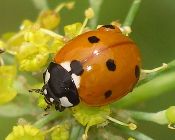 | 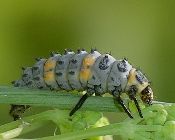 |
 |  |  |
This past spring, I was delighted to see a seven-spotted ladybug larva getting ready to pupate (fig. 4). Not having the patience to wait for the actual molt to occur, I was satisfied with checking back the next day. Sure enough, the larva had shed its old skin and was now a pupa (fig. 5). By the next day, the pupa had darkened to its normal colors (fig. 6). I planned to keep checking on a regular basis in the hope of seeing the adult eventually emerge.
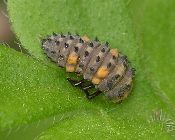 | 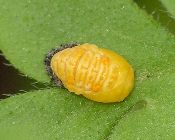 | 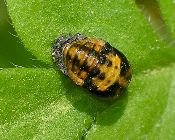 |
The other species involved in this little episode is the Multicolored Asian Ladybird Beetle (Harmonia axyridis), only a bit smaller than the seven-spotted. Both of these ladybugs were successfully introduced to the U.S. as biological controls for aphids. While the seven-spotted ladybugs always look the same, the multicolored Asian ladybug certainly warrants its first name: individuals can have from 0 to about 20 spots and their orange color can range from almost yellow (fig. 7) to almost red (fig. 8). The larvae have spiny projections and two evident orange stripes on their sides (fig. 9). I find them quite frequently in our gardens.
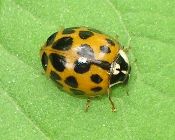 | 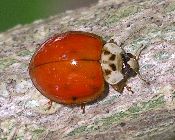 | 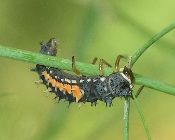 |
The very next day, I checked on the seven-spotted pupa again. Much to my surprise, it appeared that something was happening. Could the pupa have matured already and started to emerge? This seemed quite odd, since it couldn't possibly have occurred that fast. It hadn't. When I took a closer look, the real situation became evident. A multicolored Asian ladybug larva was busily munching away at the soft contents of the seven-spotted ladybug pupa (fig. 10). It had pretty much cleaned out the shell by the time I saw it. As there were two different species involved here, it wasn't technically cannibalism, but it was certainly interesting to see the startlingly gruesome way that ladybugs can eliminate the competition.
